Current Interests
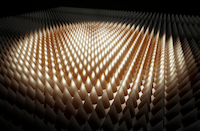 Infrared Metamaterials: We have designed and demonstrated variable thermal emitters that can help regulate their own temperature (a property we call thermal homeostasis). We are collaborating in this area with the Ravichandran Group at USC and Northrop Grumman for potential use in thermal regulation of satellites. We are also working on the design of thermal emitters with tunable spectral and directional properties, in collaboration with the Kapadia Group.
Infrared Metamaterials: We have designed and demonstrated variable thermal emitters that can help regulate their own temperature (a property we call thermal homeostasis). We are collaborating in this area with the Ravichandran Group at USC and Northrop Grumman for potential use in thermal regulation of satellites. We are also working on the design of thermal emitters with tunable spectral and directional properties, in collaboration with the Kapadia Group.
Nonreciprocal thermal emissivity and absorptivity: For all natural, non-magnetic materials, the absorptivity and emissivity at any wavelength and incident angle are equal by Kirchhoff’s Law. We have proposed a method for breaking Kirchhoff’s Law using spatiotemporal modulation of refractive index. In further work, we have shown how the wavelength of the violation can be tuned with modulation frequency, in collaboration with the Fan Group at Stanford.
Infrared detectors: We are investigating new material systems for infrared detectors. Working with JPL, we have published a series of experimental papers on resonantly-enhanced black phosphorus detectors and explored how to shape their response spectra. Currently, we are collaborating with the Wasserman, Yu, and Chen groups on optomechanical infrared detectors and the Ravichandran group on new materials approaches to polarization-dependent sensing.
Covert and encrypted communications using light: We have proposed a new method for encrypting information using infrared metamaterials and realized a first prototype experimentally.
Metasurface design methods: We maintain a strong interest in new methods for metasurface design, in order to design of complex optical functionalities not possible with standard, approximate methods. We have collaborated with multiple groups including Zongfu Yu (Wisconsin), Constantine Sideris (USC), and Owen Miller (Yale) to advance this goal. We are also helping support the legacy of our colleague Wade Hsu (USC) in the area of neural network approaches and inverse design.
Contributions to the Field
Since the group began in 2008, we have made contributions to the field of nanophotonics in several different areas, described below. Knowledge and techniques gained from these projects continue to benefit our current interests.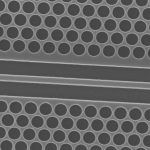
Laser propulsion: As part of the Breakthrough Starshot Initiative, we have studied the propulsion of spacecraft using laser light. In particular, we are interested in the use of nonlinear photonic crystals to make more stable laser sails. We have fabricated and characterized candidate sail materials in collaboration with Wei Wu.
Optothermal Logic: We investigated alternative logic devices that operate in extreme environments. The groundwork for these devices was established in our experimental paper on thermooptic nonlinearities in patterned silicon membranes. Drawing on this work, we published work on thermooptic memories.
Light-activated microheaters: We made thin, nanopatterned silicon membranes that act as light-activated microheaters. A first paper modeled and measured the time-dependent response of our microheaters. We have further investigated how our heaters could be used for selective or sequential heating of different areas on-chip.
Optical trapping using photonic crystals: 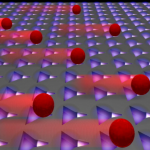 We proposed that photonic-crystal slabs can be used to trap and assemble crystalline arrays of nanoparticles. While traditional self-assembly techniques only yield energetically favorable structures, our technique takes advantage of light forces to break this constraint, enabling reconfigurable materials. Our first experimental paper demonstrated assembly of dielectric particles. A subsequent experimental paper demonstrated assembly of gold nanoparticles. We further demonstrated the first near-field optical Brownian ratchet, selective trapping of a single particle size out of a binary mixture, and immobilization of trapped particles within a polymerized matrix.
We proposed that photonic-crystal slabs can be used to trap and assemble crystalline arrays of nanoparticles. While traditional self-assembly techniques only yield energetically favorable structures, our technique takes advantage of light forces to break this constraint, enabling reconfigurable materials. Our first experimental paper demonstrated assembly of dielectric particles. A subsequent experimental paper demonstrated assembly of gold nanoparticles. We further demonstrated the first near-field optical Brownian ratchet, selective trapping of a single particle size out of a binary mixture, and immobilization of trapped particles within a polymerized matrix.
LED emission enhancement in nanostructures: We have studied how nanophotonic structures modify photoemission, in order to develop high-efficiency LED lighting. Our theoretical work predicted enhanced emission in aperiodic nanorod structures. In a collaboration with Sandia National Laboratories, we studied the effect of aperiodicity on LED beam shape in experiment. In a collaboration with the Cronin group at USC, we demonstrated enhanced Fabry-Perot resonances in surface-passivated GaAs nanowires.
Light trapping in thin-film solar cells: 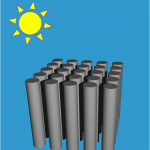 We have designed nanostructures that can efficiently absorb sunlight using a small amount of material. Such structures could yield high-efficiency, low-cost, next-generation solar cells. In an influential early paper, we showed that the solar absorptivity of properly designed nanorod arrays is higher than for a thin film, even though the nanorod array contains less absorptive material. This holds true across multiple material systems. We also showed how complex unit cells (“partial disorder”) can be used to increase solar absorption (in theory and experiment) and minimize reflection in thin-film silicon. Working with collaborators in the Dapkus and Zhou groups, we have designed and tested single-junction and tandem nanowire solar cells in III-V on silicon. We further presented detailed junction designs for surface-passivated GaAs nanowires.
We have designed nanostructures that can efficiently absorb sunlight using a small amount of material. Such structures could yield high-efficiency, low-cost, next-generation solar cells. In an influential early paper, we showed that the solar absorptivity of properly designed nanorod arrays is higher than for a thin film, even though the nanorod array contains less absorptive material. This holds true across multiple material systems. We also showed how complex unit cells (“partial disorder”) can be used to increase solar absorption (in theory and experiment) and minimize reflection in thin-film silicon. Working with collaborators in the Dapkus and Zhou groups, we have designed and tested single-junction and tandem nanowire solar cells in III-V on silicon. We further presented detailed junction designs for surface-passivated GaAs nanowires.
Measuring mechanical properties of cell membranes using optical traps: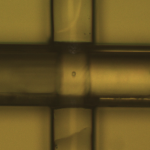 In collaboration with the Malmstadt group at USC, we have introduced the use of dual-beam optical traps for measuring the bending modulus of lipid bilayers. Our experimental paper published in Biomedical Optics Express first proposed and demonstrated this technique. We then used the technique to study the effect of lipid composition on bending modulus. Our later paper in Soft Matter presented evidence for membrane viscoelasticity.
In collaboration with the Malmstadt group at USC, we have introduced the use of dual-beam optical traps for measuring the bending modulus of lipid bilayers. Our experimental paper published in Biomedical Optics Express first proposed and demonstrated this technique. We then used the technique to study the effect of lipid composition on bending modulus. Our later paper in Soft Matter presented evidence for membrane viscoelasticity.
Optical forces in integrated photonics: We have studied the use of optical forces — mechanical forces exerted by light — on optical waveguides and microresonators. In particular, we have investigated the applications of light-induced motion in photonic circuits. Our initial 2005 theoretical article predicting optical forces between waveguides stimulated widespread activity in the field. Work at USC explored applications of optical forces to tunable birefringence and mechanical Kerr nonlinearities. Our review article summarized later developments.
Collaborators
Current collaborators at USC:
- Stephen Cronin
- Jon Habif
- Wade Hsu (recently passed)
- Rehan Kapadia
- Jayakanth Ravichandran
- Constantine Sideris
- Wei Wu
- Mengjie Yu
Outside USC:
- Caltech: Atwater Research Group
- JPL
- Naval Research Laboratory: Dr. Ginger Wheeler
- Northrop Grumman: NG-NEXT, including Dr. Luke Sweatlock, Dr. Philip Hon, and Dr. Michael Barako
- Princeton University: Nanophotonics Design and Computation Group, led by Prof. Alejandro Rodriguez
- Stanford University: Shanhui Fan Group
- UT Austin: Dan Wasserman
- U. Wisconsin Madison: Photonics Lab, led by Prof. Zongfu Yu
Resources
Funding Acknowledgements
- Aerospace Corporation
- Army Research Office
- Breakthrough Foundation
- DARPA
- Department of Energy
- JPL
- NASA
- National Academy of Engineering
- National Institutes of Health
- National Science Foundation
- NGA NURI Program
- Northrop Grumman, NG-ION2
- Raytheon
- USC Information Sciences Institute